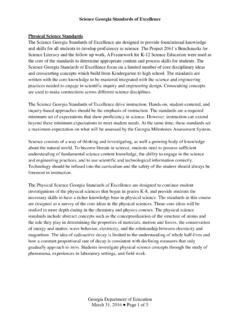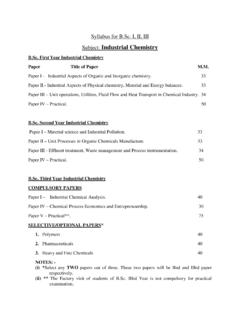Transcription of Asphalt Emulsions (Chemistry and Concepts)
1 Asphalt Emulsions ( chemistry and Concepts). Alan James, Akzo Nobel Chemicals Inc. emulsion - Definition An emulsion is a dispersion of small droplets of one liquid in another liquid. Typical examples include such everyday products as milk, mayonnaise, and cosmetic creams. Emulsions can be formed by any two immiscible liquids but in most Emulsions one of the phases is water. Oil-in- water (O/W) Emulsions are those in which the continuous phase is water and the disperse (droplet). phase is an 'oily' liquid. Water-in-oil (W/O) "inverted" Emulsions are those in which the continuous phase is an oil and the disperse phase water.
2 More complex structures are possible such as water-in-oil-in-water (W/O/W) Emulsions in which the oil droplets themselves contain smaller droplets of water. Bitumen ( Asphalt ) Emulsions are normally of the O/W type and contain from 40 to 75% bitumen, emulsifier, 25-60% water plus some minor components which are described below. They are brown liquids with consistencies from that of milk to double cream which depend mostly on the bitumen content and the particle size. The bitumen droplets range from micron in diameter and some drops may contain smaller water droplets within them so are better described as W/O/W.
3 Emulsions . This trapped' water can influence the physical properties of the emulsion . Typical particle size distribution of bitumen Emulsions with different bitumen contents. Measured on a Coulter LS230. Particle Sizer [1]. Classification of Bitumen Emulsions Bitumen Emulsions are classified according to the charge on the droplets and according to their reactivity. Cationic Emulsions have droplets which carry a positive charge. Anionic Emulsions have negatively-charged droplets. Rapid-setting Emulsions set quickly in contact with clean aggregates of low surface area such as the chippings used in chipseals (surface dressings).
4 Medium- setting Emulsions set sufficiently less quickly that they can be mixed with aggregates of low surface area such as those used in open graded mixes. Slow-setting Emulsions will mix with aggregates of high surface area. In the naming of Emulsions according to the ASTM standards, cationic rapid-, medium- and slow-setting Emulsions are denoted by the codes CRS, CMS and CSS, whereas anionic Emulsions are called RS, MS, and SS. Manufacture of Bitumen Emulsions Emulsions are made by mixing hot bitumen with water containing emulsifying agents and applying mechanical energy sufficient to break up the bitumen into droplets.
5 Bitumen Emulsions are usually made using a colloid mill where energy is applied to the system by passing the mixture of hot bitumen and water between a rotor and a stator. The disc or cone-shaped rotor may be grooved or have teeth in order to create a turbulent flow. Batch emulsion Plant Continuous emulsion Plant Emulsification is opposed by the internal cohesion and viscosity of the bitumen and the surface tension of the droplet which resists the creation of new interface. Smaller droplets are favored by a high energy input, a low bitumen viscosity and by the choice and concentration of emulsifier (which reduces the interfacial tension)[2].
6 The highest practical temperature is used to prepare the emulsion in order to reduce the bitumen viscosity. Bitumen is generally heated to 110-160 C until it has a viscosity of or less for pumping into the mill and the water phase may also be heated to 30-70oC to dissolve the emulsifiers. Hot Asphalt and water mix in the mill and temperature equilibration occurs rapidly. The temperature which determines the particle size is this temperature after mixing (=the exit temperature) and is limited to 100 C in unpressurized systems to avoid boiling of the emulsion but can reach 120 C or more in modern pressurized plant.
7 Droplets have a tendency to rejoin (coalescence) and it is necessary not only to create small drops but also to prevent their coalescence by the design of the equipment and the choice of emulsifier. Coalescence is more difficult to prevent in Emulsions of high solids content because the droplets are closer together, and as a result these Emulsions tend to have higher average particle size (see first figure). 6. 14. median particle size micron median particle size micron median particle size micron 12 4 5. large head group PMB. 10. 4. 8. 3 3 AC -5. 6. small head group 4. 2. 2 3 4 5 6 7 8 x 104 80 90 100 110 120 130 140 150.
8 Shear rate (s-1) Emulsifier level % Emulsification Temperature C. Droplet size vs. shear rate[2] vs. emulsifier concentration vs. production temperature Chemical Nature of Emulsifiers Most bitumen emulsifiers are made from renewable resources such as natural fats and oils and wood. Because they have both hydrophilic (water loving) and lipophilic ( oil-loving) portions in their molecules they concentrate at the interface between water and bitumen. This both reduces the energy required to emulsify the bitumen and prevents coalescence of the droplets once formed. A. typical emulsifier has a hydrophilic 'head' group and lipophilic 'tail' comprising 12-18 carbon atoms.
9 Emulsifiers are classified into anionic, cationic, and nonionic types depending on the charge their head groups adopt in water, although this charge may depend on pH. The emulsifier head groups are associated with counterions such as chloride or sodium. Diffusion of the counterions into the water phase leaves behind a small net charge on the Asphalt droplets and the charge on the emulsifier lipophilic tail hydrophilic head +ve uncharged -ve group cationic: quaternary amine R(tallow) --------------------------------N+(CH3)3 Cl- cationic: tallowdiamine R(tallow) --------------------------------NH2+CH2C H2CH2NH3+ 2Cl- nonionic: nonylphenolethoxylate R(nonylphenyl) ------------------------OCH2CH2 OCH2CH2 OCH2CH2O--H anionic: tall acid R(tall oil)---------------------------------COO - Na+ anionic.
10 Dodecylbenzene sulphonate R(dodecylbenzyl)---------------------SO3 - Na+ pH 2 4 6 8 10 12. Typical emulsifier structures Emulsifier head charge depends on pH. head group largely determines the charge on the Asphalt droplets. The size and sign of the charge on the droplets can be measured and is expressed as the 'zeta potential' of the droplet and there is a tendency for Emulsions containing droplets with low zeta potentials (positive or negative) to be less reactive [3]. Repulsion of like-charged droplets helps prevent close approach which could lead to flocculation and eventually to coalescence.









